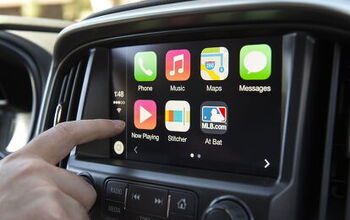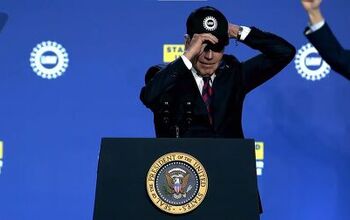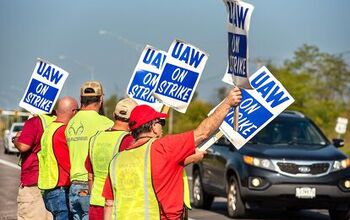Union Bargaining Begins in Detroit

The United Auto Workers (UAW) is commencing contract negotiations with General Motors, Stellantis, and the Ford Motor Company this week. Members of the union’s executive board, along with UAW President Shawn Fain, appeared outside Stellantis' Sterling Heights Assembly Plant early Wednesday morning to draw attention to the talks.
The plan is to see each manufacturer as a preamble to the formal negotiations, which technically begin on Friday. But the union is also desperate to show itself in a better light after expansive corruption scandals implicated some of its now-ousted top brass. For most people living in North America, wages haven’t kept pace with the cost of living and inflationary pressures are exacerbating the issue. If there was ever a time to get the American public back on the side of unions, it’s now.
Wednesday’s press event was a little unusual for the UAW. Normally, contract negotiations are launched with little fanfare. But Fain and friends have said they want to do things differently since assuming control. They don’t even plan on choosing a singular manufacturer on which to focus, despite this being the norm for years. Instead, the union plans on dealing with all three companies simultaneously.
"The strike target is the Big 3," Fain said on Wednesday. "If the Big 3's not going to come to the pump for workers, there's going to be issues."
He’s been promising to stay in close contact with union members and appears willing to play hardball if manufacturers aren’t willing to compromise. While the union has shown itself as willing to strike in recent years, high-profile bribery scandals have undermined its credibility as an organization.
Though it’s not as though the UAW hasn’t enjoyed any wins. The union has managed to negotiate wage increases and limits to the number of temporary employees an automaker can employ. But concessions have also been made in recent years and it could be argued that the overall trajectory for factory workers has been pretty bleak since the early 2000s — if not earlier.
"Since the Great Recession, we haven't gained, really, anything," Fain explained to the media. "And the companies have made a quarter of a trillion dollars in profits in the last decade."
Automotive News reported that the union head appeared on Facebook Live Tuesday evening to request members fill out support cards. The cards include contact information so the union can keep workers informed on bargaining updates and how they can help. Fain has said he wanted to keep members better appraised than his predecessors had and seems more willing to leverage them into pushing back against the industry.
"We've got to stop this can't-do mentality," he said. "The question I need you to think about is, 'How far are you willing to go to win the contract you deserve?'”
Getting more could be a tall order, however. Offshoring jobs has proven lucrative for domestic manufacturers. Automotive News even released a report suggesting that Ford boasting more U.S. workers than GM or Stellantis places it at a $1 billion annual cost disadvantage.
From AN:
Ford employs roughly 57,000 union workers in the U.S., about 11,000 more than GM and 16,500 more than Stellantis. It has created or retained 14,000 UAW jobs — 5,600 more than it had committed to — since signing its current contract with the union in 2019.
The automaker also has invested $1.4 billion more than what's outlined in the current four-year pact and converted roughly 14,100 temporary workers to permanent status since 2019.
The contract calls for temporary workers to represent no more than 8 percent of Ford's hourly work force; they are currently only 3 percent. Ford is believed to have a significantly lower percentage of temporary workers than GM or Stellantis.
Ford enters its negotiations with the UAW, which formally begin Friday, looking to build on those job and investment commitments. But it's also seeking ways to manage costs and maintain flexibility in its manufacturing footprint as it transitions to electric vehicles.
Compared to foreign automakers that have nonunion workers, Ford has a roughly $9-an-hour labor cost gap. All in, the company said it spends an average of $112,000 on wages and benefits per hourly worker.
Meanwhile, the UAW is expected to push for wage increases and additional benefits for its members. Despite Ford’s bottom line not being quite as robust of late, Shawn Fain has argued that all three Detroit automakers have enjoyed record profits in recent years and should be able to meet the union’s demands while still turning a profit.
He has likewise expressed his intention to reinstate cost-of-living adjustments that were dropped during the 2008 recession and to end a tiered wage system that takes workers years to reach top pay of about $32 an hour.
[Image: UAW]
Become a TTAC insider. Get the latest news, features, TTAC takes, and everything else that gets to the truth about cars first by subscribing to our newsletter.

A staunch consumer advocate tracking industry trends and regulation. Before joining TTAC, Matt spent a decade working for marketing and research firms based in NYC. Clients included several of the world’s largest automakers, global tire brands, and aftermarket part suppliers. Dissatisfied with the corporate world and resentful of having to wear suits everyday, he pivoted to writing about cars. Since then, that man has become an ardent supporter of the right-to-repair movement, been interviewed on the auto industry by national radio broadcasts, driven more rental cars than anyone ever should, participated in amateur rallying events, and received the requisite minimum training as sanctioned by the SCCA. Handy with a wrench, Matt grew up surrounded by Detroit auto workers and managed to get a pizza delivery job before he was legally eligible. He later found himself driving box trucks through Manhattan, guaranteeing future sympathy for actual truckers. He continues to conduct research pertaining to the automotive sector as an independent contractor and has since moved back to his native Michigan, closer to where the cars are born. A contrarian, Matt claims to prefer understeer — stating that front and all-wheel drive vehicles cater best to his driving style.
More by Matt Posky
Latest Car Reviews
Read moreLatest Product Reviews
Read moreRecent Comments
- Redapple2 I gave up on Honda. My 09 Accord Vs my 03. The 09s- V 6 had a slight shudder when deactivating cylinders. And the 09 did not have the 03 's electro luminescent gages. And the 09 had the most uncomfortable seats. My brother bought his 3rd and last Honda CRV. Brutal seats after 25 minutes. NOW, We are forever Toyota, Lexus, Subaru people now despite HAVING ACCESS TO gm EMPLOYEE DISCOUNT. Despite having access to the gm employee discount. Man, that is a massive statement. Wow that s bad - Under no circumstances will I have that govna crap.
- Redapple2 Front tag obscured. Rear tag - clear and sharp. Huh?
- Redapple2 I can state what NOT to buy. HK. High theft. Insurance. Unrefined NVH. Rapidly degrading interiors. HK? No way !
- Luke42 Serious answer:Now that I DD an EV, buying an EV to replace my wife’s Honda Civic is in the queue. My wife likes her Honda, she likes Apple CarPlay, and she can’t stand Elon Musk - so Tesla starts the competition with two demerit-points and Honda starts the competition with one merit-point.The Honda Prologue looked like a great candidate until Honda announced that the partnership with GM was a one-off thing and that their future EVs would be designed in-house.Now I’m more inclined toward the Blazer EV, the vehicle on which the Prologue is based. The Blazer EV and the Ultium platform won’t be orphaned by GM any time soon. But then I have to convince my wife she would like it better than her Honda Civic, and that’s a heavy lift because she doesn’t have any reason to be dissatisfied with her current car (I take care of all of the ICE-hassles for her).Since my wife’s Honda Civic is holding up well, since she likes the car, and since I take care of most of the drawbacks of drawbacks of ICE ownership for her, there’s no urgency to replace this vehicle.Honestly, if a paid-off Honda Civic is my wife’s automotive hill to die on, that’s a pretty good place to be - even though I personally have to continue dealing the hassles and expenses of ICE ownership on her behalf.My plan is simply to wait-and-see what Honda does next. Maybe they’ll introduce the perfect EV for her one day, and I’ll just go buy it.
- 2ACL I have a soft spot for high-performance, shark-nosed Lancers (I considered the less-potent Ralliart during the period in which I eventually selected my first TL SH-AWD), but it's can be challenging to find a specimen that doesn't exhibit signs of abuse, and while most of the components are sufficiently universal in their function to service without manufacturer support, the SST isn't one of them. The shops that specialize in it are familiar with the failure as described by the seller and thus might be able to fix this one at a substantial savings to replacement. There's only a handful of them in the nation, however. A salvaged unit is another option, but the usual risks are magnified by similar logistical challenges to trying to save the original.I hope this is a case of the seller overvaluing the Evo market rather than still owing or having put the mods on credit. Because the best offer won't be anywhere near the current listing.


































Comments
Join the conversation
There's a guy here in TX named Randy Adams. He has a car dealership here, and puts on a somewhat interesting radio show on local talk radio.
Last night, this guy said he strongly expects there's gonna be a huge autoworkers strike in September, which will choke new car inventory even worse than the pandemic did.
Anybody heard any evidence to support this?
Fain: Where's you're f***ng money?